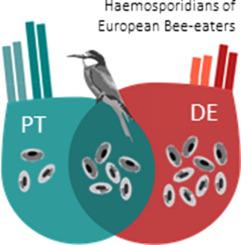International Journal for Parasitology ( IF 4 ) Pub Date : 2020-08-29 , DOI: 10.1016/j.ijpara.2020.07.005 Tamara Emmenegger 1 , José A Alves 2 , Afonso D Rocha 3 , Joana Santos Costa 3 , Raffaella Schmid 1 , Martin Schulze 4 , Steffen Hahn 1

|
Amongst other factors, host behaviour critically determines the patterns with which blood parasites occur in wild host populations. In particular, migratory hosts that sequentially occupy distant sites within and across years are expected to show distinct patterns of blood parasitism depending on their population-specific schedules and whereabouts. Here, we monitored haemosporidian parasitism in two populations of European bee-eaters (Merops apiaster), breeding in Portugal and Germany, with fundamentally different spatiotemporal migration patterns and colonisation histories. We describe and compare the composition of their parasite fauna as well as host population-, age- and sex-specific patterns in the frequency and intensity of infections. We found haemosporidian prevalence to be higher in Portugal compared with Germany and the prevalence generally increased with host age in both populations. Bee-eaters breeding in Portugal and wintering in western Africa mostly hosted parasites of the genus Haemoproteus, while Plasmodium lineages prevailed in birds breeding in Germany and wintering in central Africa. We found 18 genetic lineages, of which nine uniquely occurred in Germany, three uniquely in Portugal and six occurred in both breeding populations. The infection intensities (= % infected per inspected erythrocytes) ranged from 0.002% up to maximally 2.5% in Portugal and 9.6% in Germany. The intensity was higher in Germany compared with Portugal, vastly varied between the parasite genera (Haemoproteus > Plasmodium), but also differed between lineages of the same genus. Our results suggest that populations from different parts of a host’s breeding range differ in prevalence and the composition of their haemosporidian assemblages, rather than in the intensity of their infections. Whether these patterns are mainly caused by differential habitat use throughout the annual cycle and/or the population-specific co-evolutionary backgrounds of a host species in range expansion remains to be elucidated.
中文翻译:

欧洲食蜂鸟 (Merops apiaster) 中血孢子虫组合和感染水平的人口和年龄特定模式。
除其他因素外,宿主行为严重决定了血液寄生虫在野生宿主种群中的发生模式。特别是,预计在几年内和几年间依次占据遥远地点的迁徙宿主会根据其特定种群的时间表和下落表现出不同的血液寄生模式。在这里,我们监测了两个欧洲食蜂鸟种群(Merops apiaster),在葡萄牙和德国繁殖,具有根本不同的时空迁移模式和殖民历史。我们描述并比较了它们的寄生虫动物群的组成以及宿主人群、年龄和性别在感染频率和强度方面的特定模式。我们发现与德国相比,葡萄牙的血孢子虫流行率更高,并且这两个人群中的流行率普遍随着宿主年龄而增加。在葡萄牙繁殖和在西非越冬的食蜂鸟主要寄居 Haemoproteus属的寄生虫,而疟原虫谱系在德国的鸟类繁殖和中非的越冬中盛行。我们发现了 18 个遗传谱系,其中 9 个在德国独特,3 个在葡萄牙独特,6 个同时出现在两个育种群体中。感染强度(=每个检查的红细胞感染的百分比)在葡萄牙从 0.002% 到最大 2.5% 和德国的 9.6% 不等。与葡萄牙相比,德国的强度更高,寄生虫属之间差异很大(Haemoproteus > Plasmodium),但在同一属的谱系之间也存在差异。我们的结果表明,来自宿主繁殖范围不同部分的种群在流行率和血孢子虫组合的组成上有所不同,而不是感染强度不同。这些模式是否主要是由整个年度周期中不同的栖息地使用和/或宿主物种在范围扩展中的特定种群共同进化背景引起的,仍有待阐明。


























 京公网安备 11010802027423号
京公网安备 11010802027423号